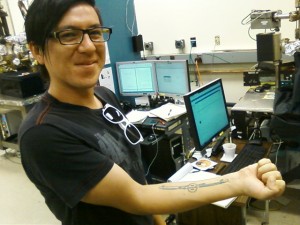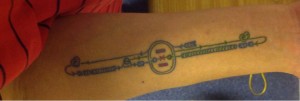From a wave function equation to a CERN bubble chamber image, the tattoos physics enthusiasts sport are wide-ranging. But is the ILC represented? Thanks to Gabriel Palacios, a physics engineering student who interned at Jefferson Lab (US) this summer, it is.
Palacios, who currently studies at Mexico City’s Metropolitan Autonomous University, had the ILC accelerator design inked on his right arm this summer, after being selected to intern with the Electron Gun Group at Jefferson Laboratory, which is working on an electron gun design for the future ILC.
For several years, Palacios had been thinking about getting a celebratory tattoo, looking ahead to earning his bachelor’s degree, which he will receive in a few months. But it was only when he found about his ILC-related internship that he decided on the ILC design.
“One of my main goals since I started studying physics was working at a collider,” Palacios said. “Being here at Jefferson Lab was achieving just the first stage of that dream.”
The dream began in high school with a physics teacher who fascinated Palacios with stories of colliders, an unheard-of topic in his small Mexican hometown of 50,000.
“He was talking magic to us,” Palacios said.
Years later, in December 2012, Palacios applied to a summer programme hosted by the Mexican Physical Society’s Division of Particles and Fields. A committee of professors and researchers selected Palacios, along with four other physics undergraduates from across Mexico, to intern at an international high-energy physics lab. For Palacios, that lab was Jefferson Lab in Newport News, Virginia.
“He impressed everyone with his knowledge, his motivation, his open and confident personality,” said Carlos Hernandez-Garcia, a scientist for the Free Electron Laser Program at Jefferson Lab who helped choose the five students.
At Jefferson Lab, Palacios worked with the Electron Gun Group, a team whose job is to generate the electron beam for the lab’s particle accelerator, the Continuous Electron Beam Accelerator Facility (CEBAF). Generating an electron beam requires an electron gun. In the gun, a laser beam shines on a photocathode, releasing electrons that are then grouped together and accelerated using electric fields. Palacios’ project involved evaluating new photocathodes that could be used for CEBAF’s electron gun or for the group’s ILC’s electron gun design.
“He’s a really good worker and so enthusiastic, it doesn’t really surprise me (that he got an ILC tattoo),” said Matt Poelker, head of the Electron Gun Group at Jefferson Lab.
Now that his ten weeks at Jefferson Lab are complete, Palacios plans to finish his bachelor’s degree and then attend graduate school. Working on an ILC-related project in the future would be the next phase of his original dream.
“It’s about participating in this amazing project that gets people from around the world together to study something that is going to give us a huge clue of what the universe is about,” Palacios said.
As for future tattoos, Palacios said a particle collision is next on his list—the burst of energy located squarely in the middle of his chest.



Nice! I’m wondering why this idea did not cross my mind… 🙂